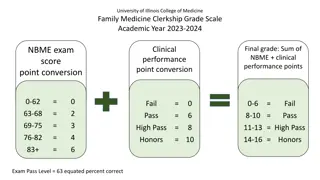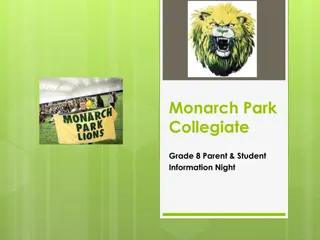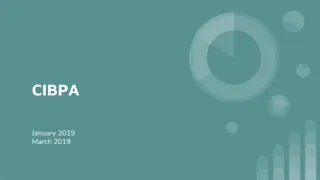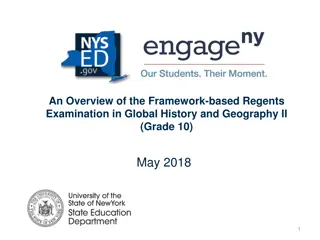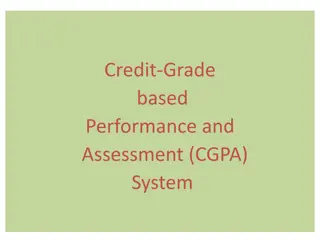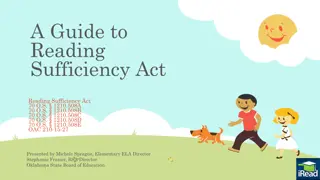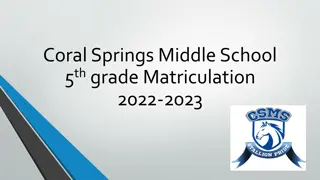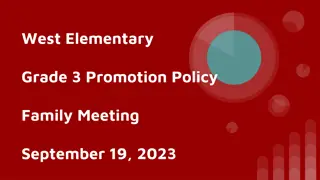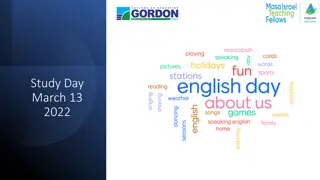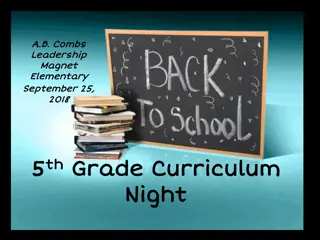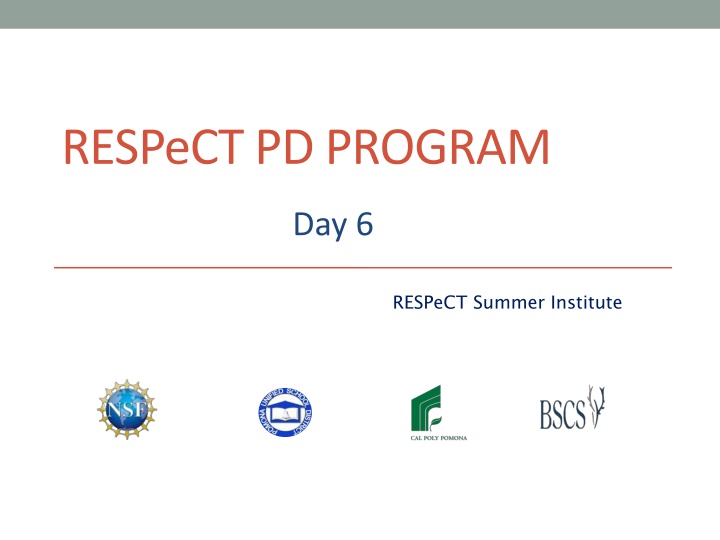
Enhancing Science Content Storyline: Strategies and Reflections
Explore strategies like STeLLA and SCSL to help students develop a coherent science content storyline. Reflect on lessons, focus questions, and deepening content on forces and more. Engage in discussions on lesson analysis and selecting appropriate science activities.
Uploaded on | 0 Views
Download Presentation

Please find below an Image/Link to download the presentation.
The content on the website is provided AS IS for your information and personal use only. It may not be sold, licensed, or shared on other websites without obtaining consent from the author. If you encounter any issues during the download, it is possible that the publisher has removed the file from their server.
You are allowed to download the files provided on this website for personal or commercial use, subject to the condition that they are used lawfully. All files are the property of their respective owners.
The content on the website is provided AS IS for your information and personal use only. It may not be sold, licensed, or shared on other websites without obtaining consent from the author.
E N D
Presentation Transcript
RESPeCTPD PROGRAM Day 6 RESPeCT Summer Institute
Agenda for Day 6 Day-5 reflections Review: Science content storyline Today s focus questions Lesson analysis: STeLLA strategies B, I, and 7 Content deepening: forces Lunch Content deepening (continued) Lesson analysis: SCSL strategy C Summary, homework, and reflections
Trends in Reflections Lesson Analysis Science Content Learning
Review: Science Content Storyline In your notebooks, jot down 3 things you remember from yesterday s session, 2 ideas that seem important to you, and 1 question you have. Be prepared to share one idea and question with the group.
Todays Focus Questions How can we begin and end a lesson to help students develop a coherent science content storyline? How can selecting appropriate science activities help students develop a coherent science content storyline? Why do moving objects slow down and eventually stop? What force makes a moving object slow down and eventually stop?
Lesson Analysis: Focus Question 1 How can we begin and end a lesson to help students develop a coherent science content storyline?
Strategies B, I, and 7: Purposes and Key Features Group 1: What are the purpose and key features of strategy B? Why is a focus question or goal statement important for science content storyline coherence? Group 2: What are the purpose and key features of strategy I? Why is summarizing key science ideas important for science content storyline coherence? Group 3: What are the purpose and key features of strategy 7? How does strategy 7 compare with strategy I? All groups: Make sure to cite ideas from the STeLLA strategies booklet in your answers.
Discussion Questions: Strategy B 1. What is the difference between focus questions and goal statements? 2. Which do you think would be more useful in engaging student interest and making their thinking visible focus questions or goal statements?
Discussion Questions: Strategies I and 7 1. What are various ways a lesson or unit can be synthesized and/or summarized? 2. How are strategies I and 7 similar and different? a. SCSL strategy I: Summarize key science ideas. b. STL strategy 7: Engage students in making connections by synthesizing and summarizing key science ideas.
Video-based Lesson Analysis Next we ll analyze two video clips from the beginning and end of a lesson on forces.
Lesson Analysis: Strategy B 1. In Analysis Guides B and I (handout 6.1), review the four criteria for strategy B: Setting the purpose. 2. Read the lesson context at the top of the video transcript (handout 6.2). 3. Watch the first video clip, keeping in mind the criteria for strategy B. 4. Analyze the transcript using the analysis guide. How well does the beginning of this lesson match the criteria for strategy B? 5. Share and compare your analyses. Link to video clip 1: 6.1_mspcp_gr.3.forces_torres_L1_c1-2
Lesson Analysis: Strategy I 1. In Analysis Guides B and I (handout 6.1), review the six criteria for strategy I: Summarizing key science ideas. 2. Review the lesson context at the top of the video transcript (handout 6.3). 3. Watch the second video clip, keeping in mind the criteria for strategy I. 4. Analyze the transcript using the analysis guide. How well does the end of this lesson match the criteria for strategy I? 5. Share and compare your analyses. Link to video clip 2: 6.2_mspcp_gr.3.forces_torres_L1_c5
The Forces Lesson Plans: Reading and Analysis 1. Examine the main learning goal, the lesson focus question, and the lesson summary for your assigned Forces lesson plan (parts A and B). 2. Answer these questions in your notebooks, keeping in mind the analysis-guide criteria for strategies B and I: What do you notice? What do you wonder about?
FORCES SCIENCE CONTENT DEEPENING Grade 3
Content Deepening Homework Share a new idea or question from the content deepening homework. What helped clarify your understandings of the science content? What idea was new to you? What idea were you confused about? What big idea do you think is important to highlight for students? What burning question do you have?
Unit Central Questions What makes something start to move? What makes something stop moving or change direction?
Content Deepening: Focus Question 1 Why do moving objects slow down and eventually stop?
Investigation 1: Does the Surface Matter? Think about this scenario: Students rolled a soccer ball over three different surfaces: Grass Blacktop on the playground Tile flooring in the school hallway The students tried to use the same force each time. Then they measured how far the ball rolled. Question: Do you think the ball traveled the same distance on all three surfaces? Why or why not?
Investigation 1: Does the Surface Matter? Carpet Car Ramp Meter Stick Photo courtesy of BSCS
Investigation 1: Does the Surface Matter? Record your distance measurements on this data table in the handout. Surface Distance Trial 1 Distance Trial 2 Distance Trial 3 Middle Distance Carpet Tile Sandpaper
Investigation 1: Does the Surface Matter? Record your team s Middle Distance measurement on the class data table. Surface Team 1 Team 2 Team 3 Team 4 Team 5 Team 6 Team 7 Carpet Tile Sandpaper
Investigation 1: Does the Surface Matter? What patterns do you see in the class data? Do these results match your predictions?
Investigation 1: Does the Surface Matter? Question 1: Why do you think the car traveled different distances over the three surfaces? Write your explanation on the handout. Make sure to support your ideas with evidence from the data table and our investigation.
Investigation 1: Does the Surface Matter? Question 2: If forces make an object start to move, do they also have something to do with making an object stop moving? Think about this question. Then complete the sentence on the handout: I think forces [do/do not] have something to do with making an object stop moving because __________________________. Use evidence from your investigation to explain your answer.
Reflect: Content Deepening Focus Question 1 Why do moving objects slow down and eventually stop?
Key Science Ideas The surface an object moves over or through has something to do with the object slowing down and stopping. Moving objects slow down and stop at different distances on different surfaces. Objects take longer to slow down and stop on smooth surfaces, but they slow down and stop more quickly on rough surfaces. So differences in surface texture must have something to do with variations in the distance an object travels when the same force is applied.
Content Deepening: Focus Question 2 What force makes a moving object slow down and eventually stop?
Lets Analyze Our Data! Why do you think the car traveled different distances over the three surfaces? What do you think the bumpiness of the surface had to do with the distance the car rolled before it stopped? Based on our data, do we all agree that an object will move farther on a smooth surface than it will on a rough surface?
Investigation 2: The Hand-Strip Model Describe the surface of the hand strip. How is the hand strip like or not like the three surfaces (carpet, tile, and sandpaper)? What do you think will happen when the toy car rolls over the hand strip?
Investigation 2: The Hand-Strip Model Why do you think the car stopped? (Use the words force, push, or pull in your explanation.)
Investigation 2: The Hand-Strip Model Take turns using the hand lens (magnifying glass) to examine the three surfaces (carpet, tile, sandpaper). Think about how each surface is like or not like the hand strip. Discuss these questions with your partner; then record your observations in your science notebook: 1. How is the carpet like or not like the hand strip? 2. How is the sandpaper like or not like the hand strip? 3. How is the tile like or not like the hand strip?
Investigation 2: The Hand-Strip Model Create a data table in your science notebook and describe how the three surfaces are like or not like the hand strip. Like the Hand Strip Not Like the Hand Strip Carpet Sandpaper Tile
Investigation 2: The Hand-Strip Model Share the observations you recorded on your data table. How is the carpet like or not like the hand strip? How is the sandpaper like or not like the hand strip? How is the tile like or not like the hand strip?
Investigation 2: The Hand-Strip Model Can we agree that the carpet is most like the hand strip? What would you say is the main difference between the carpet and the tile when you compare it with the hand strip? Why do you think the car travels the shortest distance over both the carpet and the hand strip? What does this have to do with our science idea of force?
Key Science Idea Friction is a force that s created when bumps on the surfaces of two objects push against one another. Friction is what causes moving objects to slow down and eventually stop.
Investigation 3: What Is Friction? Locate Forces handout 4.2 (Friction) in your lesson plans binder. Think about these questions as you read the essay: 1. What causes friction? 2. Why does friction exert a different amount of force on different surfaces? 3. What would happen if there were no friction acting on an object? (Hint: What would happen in outer space?)
Investigation 3: What Is Friction? Reread the fourth and fifth paragraphs of the essay. How do these paragraphs relate to what you observed when you used a hand lens to examine the wheels of the toy car and the three surfaces (carpet, tile, and sandpaper)? What happens when tiny bumps on the surface of one object push against tiny bumps on the surface of another object? Why do the bumps matter?
Reflect: Content Deepening Focus Question 2 What forcemakes a moving object slow down and eventually stop? Write your best answer to this question in your science notebook. Describe friction in your own words using the key science ideas and terms you ve learned about so far.
Key Science Ideas Friction is a force that s created when bumps on the surfaces of two objects push against one another. Friction is what causes moving objects to slow down and eventually stop. Rougher, bumpier surfaces create more friction, causing objects to slow down and stop more quickly. Smoother surfaces create less friction, causing objects to travel farther before they stop.
Review: Forces and Motion What causes a change in an object s motion? What is net force? How do scientists represent a force acting on an object?
Questions to Think About What is the direction of a frictional force on an object that is sliding or rolling across a surface? What is the direction of a frictional force on an object at rest that is trying to start sliding across a surface? Why are massive objects harder to slide across the floor than light-weight objects?
Friction: Tall Grass versus Asphalt Scenario: Two toy cars coasting at the same speed encounter two different surfaces: tall grass and asphalt. Why does the car driving through tall grass slow down faster than the car traveling over asphalt? Tall Grass Asphalt Courtesy of Hector Mireles
Types of Friction Rolling friction: A force that resists or opposes motion when an object rolls over a surface. Sliding (dynamic) friction: A force that resists or opposes motion when an object slides across a surface. Static friction: A force that opposes the initial push on an object to get it moving. The force of friction equals the force of the push, so the object doesn t move. Fluid friction (draft force): The force that resists the movement of an object through water or air.
Rolling Friction Scenario: Two identical soccer balls are rolling over different surfaces. One ball is rolling over a concrete surface, and the other ball is rolling over a grassy surface. Draw all of the forces acting on the soccer balls. Courtesy of Hector Mireles
Rolling Friction A force that resists or opposes an object s motion when it rolls over a surface. Where might you encounter rolling friction in everyday life? Examples: Coasting in your car after it runs out of gas Pushing a shopping cart down a grocery aisle
Sliding Friction A force that resists or opposes an object s motion when it slides across a surface. The strength of the frictional force depends on the following: 1. The surface composition of both objects 2. The normal force the surface exerts on the object moving over it. Questions: Which frictional force is greater? Why? 1. Tires skidding on dry pavement OR wet pavement 2. An empty box OR a full box of books sliding across the floor
Sliding Friction Scenario: Two identical hockey pucks glide over different surfaces: smooth ice and playground asphalt. Draw all of the forces acting on the hockey pucks. Smooth Ice Playground Asphalt Courtesy of Hector Mireles
Static Friction A force that opposes the initial push on an object to get it moving. Key ideas: Static friction acts in the opposite direction of the intended motion of an object. The force of friction equals the force of the push, so the object doesn t move. The strength of the frictional force is just enough to resist the opposing force pushing on the object. Maximum strength can be reached by applying a larger force.
Static Friction Scenario: A child tries and tries to push a box of science books, but the box doesn t budge. Then his father comes along and gives the box a good shove with his boot to get it moving. Courtesy of Hector Mireles



